Fertility Clinic Statistics: Using SART Data to Choose Your Clinic
February 11th, 2021 | 6 min. read
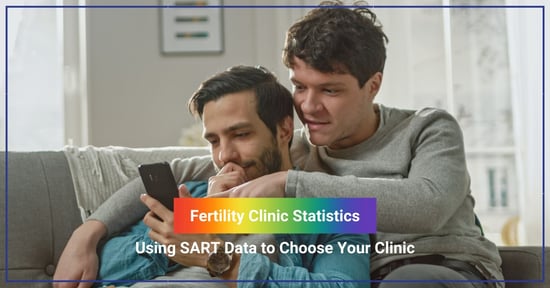
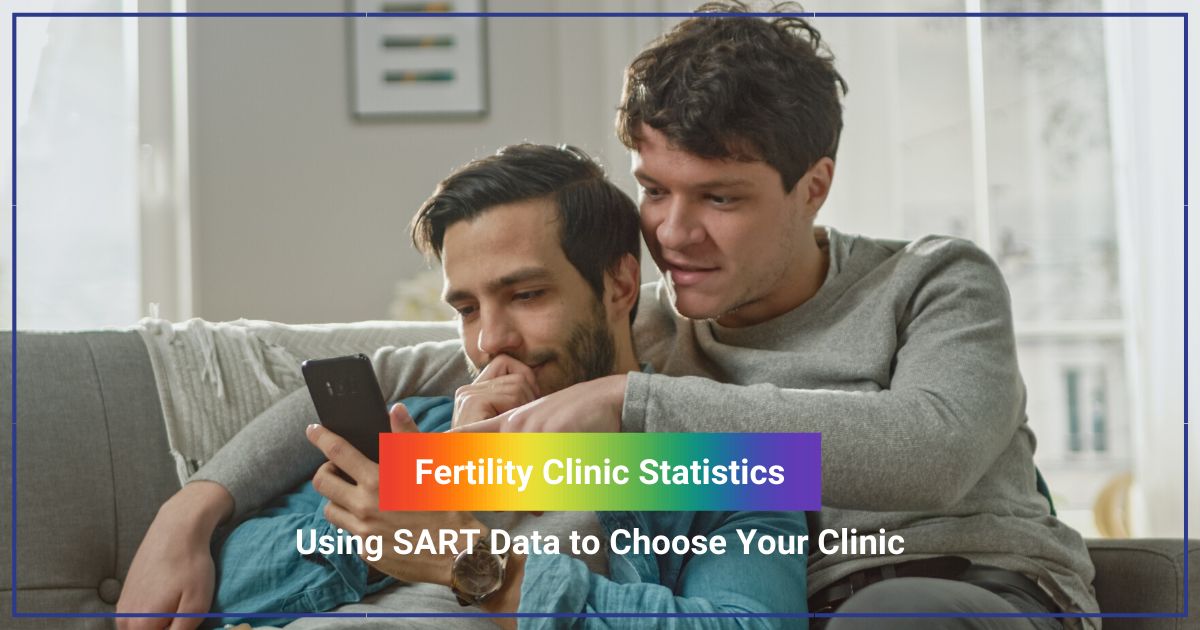 So, you’ve decided that being a parent is in your future - congratulations! This is a major life-decision, and personally, as a parent of two young children, I can say whole-heartedly that being a parent is the most rewarding and hardest job you’ll ever have.
So, you’ve decided that being a parent is in your future - congratulations! This is a major life-decision, and personally, as a parent of two young children, I can say whole-heartedly that being a parent is the most rewarding and hardest job you’ll ever have.
If you’re reading this article, you've likely done your preliminary research on adoption, fostering-to-adopt, and surrogacy, and decided that biological parenthood is the path for you. You’ve probably also become a little overwhelmed by all of the information and misinformation that’s out there on the world wide web. Don’t get discouraged - after helping hundreds of singles and couples become parents through surrogacy here at Gay Parents To Be, and going through this process myself, I can safely say, “It’s worth it.”
If you’re like most hopeful parents-to-be, perhaps you’ve searched for fertility clinics local to you, or the best clinic for LGBTQ singles and couples. It’s important to remember that there is a specific set of hopes and challenges surrounding LGBTQ surrogacy journeys, and ideally, your chosen clinic will have experience in this area. Certifications that indicate a level of LGBTQ inclusivity such as the Healthcare Equality Index or the Open Door training offered by Family Equality are other great markers to look for. Overall, you should base your choice of a clinic on your level of comfort with the practice and your physician, LGBTQ-specific care experience and competency, and a proven record of success. In addition to these crucial factors, here are five considerations that should help round out your research phase, after which hopefully a few clinics will stand-out.
1. What Online Resources Evaluate Fertility Clinic Success?
How is “success” determined in the world of fertility clinics? Luckily, in the United States, it is federally required that all fertility clinics report to the CDC - this ensures that safe and successful laboratory and clinical practices are being followed, for your health and the health of your surrogate and future child. You should be aware that fertility clinics are inspected by the FDA every two years specifically in regard to how cycles including egg donors and surrogates are managed. Additionally, there is a separate organization that over 90% of fertility clinics in the U.S. choose to report to, called SART (or, the Society for Assisted Reproductive Technology). SART data is freely available online, and the rates posted reflect data from only a few years prior.
For hopeful parents-to-be, this can be an amazing resource - a way to access clinic specific data. It can also be confusing! There are a lot of numbers and different terms listed - singleton births, pre-term and very pre-term, and implantation rate, to name a few. In this article we will explain some key terms to help demystify SART data, as well as surrogacy statistics that you should take a look at when selecting your future clinic.
2. Where Do I Go To Find Data on My Fertility Clinic?
In order to look at an individual clinic’s rates, you can visit the SART website and click on the “Find a Clinic” tab. You will then be able to select between a few years of data results that your clinic has reported. For gay men, the surrogacy process involves creating embryos using donor eggs, freezing them, THEN thawing them and placing them in a gestational carrier. So you will primarily be looking at the “Donor Egg” tab and the subsection “Thawed Embryos”.
3. Why Are Surrogacy Success Rates Different?
Now you may be wondering, “why are the rates listed in the thawed Donor Egg section different from the overall success rate?” Typically speaking, gay men seeking to build their families biologically have a higher chance of success compared to many opposite-sex couples who need the help of a fertility clinic. The reason being, your family plan will leverage the help of a young, healthy, egg donor, and a gestational carrier who has successfully carried and delivered a pregnancy. While it is a good idea to look at a clinic’s overall success rates, remember that those numbers are a composite of all the practice’s patients, not just the donor egg surrogacy group.
When you look at the data, you will see rates listed in a number of different categories. In my opinion, the top two statistics that parents should look at are live birth rate and the rates of prematurity (pre-term and very pre-term births). While all of the other numbers are important, and may demonstrate a clinic’s success, your main concern as a parent is that your baby is born healthy and safe.
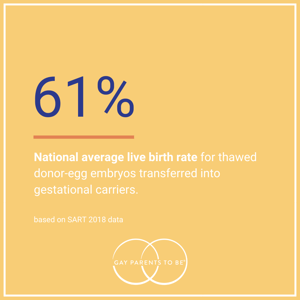
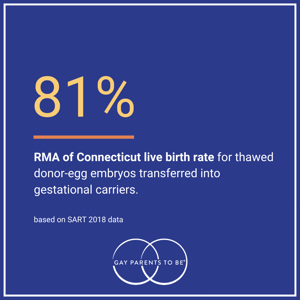
Live Birth Rate
Means exactly what you think it does. The live birth rate is a report of how many embryo transfers resulted in the birth of a child.
Pre-Term Birth
Pre-term birth is a live birth where the child is born between 32-37 weeks.
Very Pre-Term Birth
A very pre-term birth is when the child is born before 32 weeks, and often results in weeks of care in the neonatal unit, and other complications. While pre-term and very pre-term are both “live birth” categories, there are significantly more potential medical risks for babies in either of these categories than babies delivered after 37 weeks.
4. Why Is the Implantation Rate Different from the Live Birth Rate?
Implantation rate is another important number that measures the success of the clinic, but you may notice that it differs from the live birth rate. A clinic’s implantation rate demonstrates embryonic competence or quality, as it measures the chance that an embryo will attach and implant into the uterine wall.
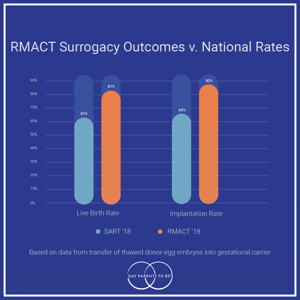
A high implantation rate is an indicator of a good IVF laboratory that is able to create high quality embryos. Unfortunately, even under the best circumstances miscarriages can occur, so you may see that the implantation rate and the live birth rate are different.
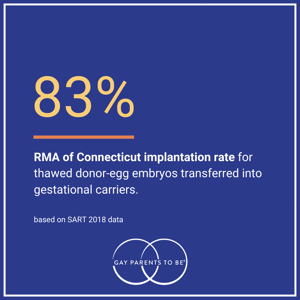
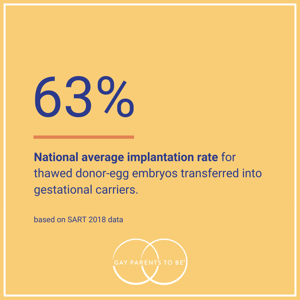
5. What About Twins? Are More Embryos Better?
The rate of implantation is important because it speaks to the quality of embryos created, not just a high pregnancy rate based on the number of embryos transferred. Although the American Society for Reproductive Medicine recommends a single (one) embryo transfer for any patients using donor eggs, many clinics will transfer more than one embryo.
More than one embryo means a greater chance of success, right? Not necessarily. We all know that the added expense of additional surrogacy journeys can be a real concern for most prospective parents. However, an increased number of embryos transferred not only increases the chances for implantation, but also the chances of multiples. While adorable twins or triplets may sound like a dream come true, oftentimes a multiple pregnancy incurs a greater risk for both the woman who is pregnant and the children. Multiples are frequently delivered pre- or very pre-term, and carry additional developmental risks.
Thanks to modern medicine and advances in assisted reproductive technology, gay parents to be around the country are working with fertility clinics to build their families. Ultimately, your choice of a fertility clinic is a highly personal one - surrogacy journeys can take upwards of 18 months, so you will be spending a lot of time sharing experiences with your doctors, nurses, and administrative staff. At times it may seem overwhelming, but we’re all working towards a common goal, and we can’t wait for you to bring home a healthy, happy baby. Don’t forget to send baby pictures!
Interested in learning more about how long surrogacy actually takes? Read more here.
Dr. Mark P. Leondires is the Founder and Medical Director of Illume Fertility, an inclusive, award-winning fertility clinic with five locations in Connecticut and New York. Dr. Leondires is board-certified in both Obstetrics and Gynecology and Reproductive Endocrinology and Infertility. Dr. Leondires is also the Founder of Gay Parents To Be, a leading family-building resource for the LGBTQ+ community - a passion project created after undergoing his own journey to parenthood as a gay dad.

